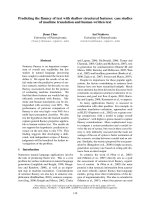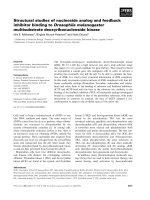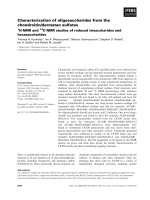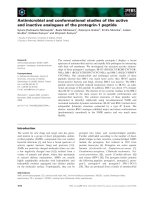Ageing well studies of its global and multidomain and construct among multi ethnic singaporean seniors
Bạn đang xem bản rút gọn của tài liệu. Xem và tải ngay bản đầy đủ của tài liệu tại đây (7.46 MB, 295 trang )
AGEING WELL: STUDIES OF ITS GLOBAL AND
MULTIDOMAIN AND CONSTRUCT AMONG MULTI-
ETHNIC SINGAPOREAN SENIORS
GWEE XINYI
(BACHELOR OF ARTS (HONOURS) IN PSYCHOLOGY),
UWA
A THESIS SUBMITTED FOR THE DEGREE OF
DOCTOR OF PHILOSOPHY
DEPARTMENT OF PSYCHOLOGICAL MEDICINE
NATIONAL UNIVERSITY OF SINGAPORE
2013
I
DECLARATION
I hereby declare that this thesis is my original work and it has been written by
me in its entirety. I have duly acknowledged all the sources of information
which have been used in the thesis.
This thesis has also not been submitted for any degree in any university
previously.
___________________________
Gwee Xinyi
15 August 2013
II
ACKNOWLEDGEMNT
I would like to express my utmost gratitude to my supervisor, Associate
Professor Ng Tze Pin, for his guidance and patience. His expertise,
encouragement and invaluable advice made the completion of this research
thesis a possibility.
I also wish to express my sincere thanks to: my Thesis Advisory committee
members, Dr Jonathan Marshall and Dr Philip Yap; all team members of the
Gerontology Research Programme as well as the Department of Psychological
Medicine, NUS, for all the helps and supports for my study and research
throughout my candidature. In particular, I would like to thank Dr Rajeev
Kumar and Professor Kua Ee Heok for their generosity and support in
allowing me to use the Singapore Study of Successful Ageing as part of my
research thesis.
I would like to gratefully acknowledge the social service centers, senior
activity centers and all participants for their kind support and participation in
this study. Without their kind contribution and understanding, the research of
this thesis would not be possible.
Last but not least, I would like to acknowledge all the funding bodies as well
as National University of Singapore for awarding me the Research
Scholarship. The studies were supported by research grant funding from the
Biomedical Research Council, Agency for Science, Technology and Research
(ASTAR) (No. 03/1/21/17/214), National University of Singapore Academic
Research Fund, and Lee Foundation.
III
CONTENTS
PAGE
DECLARATION PAGE
I
ACKNOWLEDGEMENT
II
ABSTRACT
IX
LIST OF TABLES
XI
LIST OF FIGURES
XIII
LIST OF ABBREVIATIONS
XIV
LIST OF PUBLICATIONS
XVI
LIST OF APPENDICES
XVII
CHAPTER 1. INTRODUCTION
1.1 Fast ageing population and its impact
1
1.2 Singapore and successful ageing
2
1.3 History on the construct of successful ageing
3
1.4 Multidimensional construct of successful ageing
5
1.5 Global construct of successful ageing
6
1.6 Measurement: Multidimensional construct of successful ageing
7
1.7 Measurement: Global construct of successful ageing
8
1.8 Ethnic and cultural dimensions in successful ageing
9
1.9 Overall objective and hypothesis of the thesis
10
1.9.1 Objective and hypothesis: Study I
12
1.9.2 Objective and hypothesis: Study II
14
1.9.3 Objective and hypothesis: Study III
16
1.9.4 Objective and hypothesis: Study IV
17
CHAPTER 2. LITERATURE REVIEW
2.1 Biomedical models and successful ageing
19
2.1.1 Physical activity and successful ageing
20
2.1.2 Health behaviours and successful ageing
21
2.1.3 Cognitive functioning and successful ageing
21
IV
CONTENTS
PAGE
2.2 Social functioning models and successful ageing
22
2.2.1 Theories underlying social functioning and successful
ageing
22
2.2.1.1 Continuity theory
22
2.2.2 Physical, social, productive activities and successful
ageing
23
2.2.3 Social support / functioning and successful ageing
24
2.3 Psychological models and successful ageing
25
2.3.1 Theories underlying psychological coping and
successful ageing
26
2.3.1.1 Theory of selective optimization with compensation
(SOC)
26
2.3.1.2 Stress process theory
27
2.3.2 Psychological adaptation / coping and successful
ageing
28
2.3.3 Psychological resilience and successful ageing
29
2.4 Religiosity / spirituality and successful ageing
29
2.4.1 Mechanisms underlying religiosity/ spirituality and
successful ageing
30
2.4.1.1 Association between religiosity/ spirituality and
positive health behaviours or practices
30
2.4.1.2 Association between religion and social integration
or support
31
2.4.1.3 Association between religion and comfort
32
2.4.2 Evidence: religiosity / spirituality and successful
ageing
34
2.5 Predictors of successful ageing
35
2.6 Multidimensional models of successful ageing: review
36
2.7 Prevalence of successful ageing: self-rated and objectively
measured using researcher-defined criteria
39
V
CONTENTS
PAGE
2.8 Other outcome measures of successful ageing
42
2.8.1 Life satisfaction and successful ageing
42
2.8.2 Quality of life and successful ageing
42
2.9 Ethnic and cultural dimensions in successful ageing
43
CHAPTER 3. METHODS
3.1 METHOD: Study I
48
3.1.1 Research design
48
3.1.2 Population and sample
49
3.1.3 Measurements
49
3.1.3.1 Assessment of multidimensional model of successful
ageing
49
3.1.3.2 Assessment of physical health and functional well-
being dimensions
50
3.1.3.3 Assessment of cognitive function and emotional
well-being dimension
51
3.1.3.4 Assessment of social functioning and active
engagement in activities dimension
52
3.1.3.5 Assessment of life satisfaction dimension
52
3.1.3.6 Assessment of spirituality
53
3.1.3.7 Assessment of social network and support
53
3.1.3.8 Assessment of health behaviours
53
3.1.3.9 Assessment of health status
54
3.1.3.10 Assessment of health-care use
54
3.1.3.11 Assessment of nutritional risk status- Nutrition
Screening Initiative (NSI)
54
3.1.3.12 Assessment of Body Mass Index (BMI)
55
3.1.3.13 Assessment of Balance and gait
55
VI
CONTENTS
PAGE
3.1.3.14 Assessment of hearing and visual impairment
56
3.1.3.15 Assessment of quality of life
56
3.1.3.16 Assessment of socio-demographic background
56
3.1.4 Data Analyses
56
3.2 METHOD: Study II
59
3.2.1 Research design
60
3.2.2 Population and sample
60
3.2.3 Measurements
61
3.2.3.1 Assessment of self-rated single-item scale of global
successful aging
62
3.2.3.2 Assessment of dimensional measures of successful
ageing
62
3.2.3.3 Dimension of successful ageing model: Assessment
of physical health and function component
63
3.2.3.4 Dimension of successful ageing model: Assessment
of mental / cognitive well-being component
64
3.2.3.5 Dimension of successful ageing model: Assessment
of social engagement component
64
3.2.3.6 Dimension of successful ageing model: Assessment
of psychological well-being component
65
3.2.3.7 Dimension of successful ageing model: Assessment
of spirituality and religiosity component
66
3.2.3.8 Dimension of successful ageing model: Assessment
of quality of life
67
3.2.3.9 Dimension of successful ageing model: Assessment
of life satisfaction
67
3.2.3.10 Assessment of socio-demographic background
68
3.2.4 Data analyses
68
3.3 METHOD: Study III
70
3.3.1 Research design; population and sample
70
VII
CONTENTS
PAGE
3.3.2 Measurements
70
3.3.2.1 Assessment of self-rated global successful aging
71
3.3.2.2 Assessment of ageing perceptions
71
3.3.2.3 Assessment of mortality salience and religiosity /
spirituality
72
3.3.2.4 Assessment of self-reported health status
73
3.3.2.5 Assessment on life satisfaction
74
3.3.2.6 Assessment of views on important successful ageing
factors
74
3.3.2.7 Assessment of socio-demographic background
75
3.3.3 Data analyses
75
3.4 METHOD: Study IV
76
3.4.1 Research design
76
3.4.2 Population and sample
77
3.4.3 Measurements
78
3.4.4 Data collection procedure
78
3.4.5 Data analyses
82
CHAPTER 4. RESULTS & DISCUSSION: STUDY I
4.1 Results
88
4.2 Discussion
98
CHAPTER 5. RESULTS & DISCUSSION: STUDY II
5.1 Results
103
5.2 Discussion
114
CHAPTER 6. RESULTS & DISCUSSION: STUDY III
6.1 Results
119
6.2 Discussion
134
VIII
CONTENTS
PAGE
CHAPTER 7. RESULTS & DISCUSSION: STUDY IV
7.1 Results
140
7.2 Discussion
161
CHAPTER 8. SUMMARY AND CONCLUSION
Summary
169
Conclusion
173
Strengths and Limitations
174
Implications of Findings
176
Recommendation and Future Studies
178
References
180
Appendix 1
202
Appendix 2
212
Appendix 3
234
Appendix 4
268
Appendix 5
271
Appendix 6
275
Appendix 7
276
Appendix 8
277
IX
ABSTRACT
Background: There is lack of research examining the construct and
measurement of successful ageing among Singaporean older adults. It is
important to understand successful ageing within socio-cultural context as it is
influenced by environmental factors.
Objectives: To explore multidimensional and global constructs of successful
ageing among Singaporean Chinese, Malay and Indian older adults aged 65
and above. We first evaluated the validity of a broad multidimensional model
of successful ageing (study I). Next, the validity and reliability of a self-rated
single-item scale of global successful ageing was examined (study II).
Gender and ethnic-based differences in subjective ratings on the self-rated
single-item scale of global successful ageing and in relation to variables
associated with successful ageing was investigated in study III. Study IV
further explored the subjective perceptions of successful ageing.
Methods: Four studies were reported in this thesis. In study I,
multidimensional model of successful ageing (physical health and well-
functioning; cognitive and emotional well-functioning; higher social
functioning and active life engagement and high life satisfaction) was
examined using cross-sectional (N=1281) and longitudinal (N=865) secondary
data from Chinese participants in the Singapore Longitudinal Ageing Study.
In study II, cross-sectional analyses were performed on 489 participants from
Singapore Study of Successful Ageing (SSOSA). The self-rated single-item
scale of global successful ageing was analysed for its relationship to
dimensional models of successful ageing (physical health and function; mental
well-being; social functioning; psychological and spirituality), including
outcome measures (life satisfaction and quality of life). Reliability of the
scale was assessed with 33 participants. Study III used SSOSA data from
495 participants to explore gender and ethnic-based differences in subjective
ratings on the self-rated single-item scale of global successful ageing and in
relation to ageing perceptions, mortality salience/spirituality, health status, and
life satisfaction. Study IV explored successful ageing in 8 focus groups of 46
participants using qualitative research methodology.
X
Results: The multidimensional model of successful ageing demonstrated good
convergent validity with concurrent health status and healthcare use
parameters. Baseline successful ageing status was also significantly
associated with better quality of life measured with SF-12 MCS, F(1,
865)=7.9, p=<.001, and PCS, F(1, 865)=5.8, p=<.05 (Study I). The self-rated
single-item scale of global successful ageing was significantly correlated to all
dimensional models of successful ageing (r from 0.11 to 0.30). The scale was
also the best predictor of life satisfaction (beta=.54; R
2
=28.9%). Excellent
test-retest correlations were found, r=0.93 (Study II). Gender and ethnic
differences were found in study III. Females [F(1, 494)=8.23, p<.01] and
Malays [F(2, 493)=4.11, p<.05] rated themselves to be ageing more
successfully despite facing more limitations in performing physical
functioning activities. In study IV, physical and cognitive well-being;
harmonious family relations; meaningful social engagement and network;
positive adaptation and emotional wellness; positive spirituality; and sufficient
financial resources and autonomy were expressed as important for successful
ageing. Culture-specific factors relating to family relationships and religiosity
were found.
Conclusion: This thesis supports the use of a self-rated single-item scale of
global successful ageing that may be used as a universally acceptable standard
measurement for use in population monitoring and comparative analyses.
Criterion-based multidimensional measures of successful ageing, given some
practical limitations, remain potentially useful in programme intervention and
evaluation for relevant outcomes.
XI
LIST OF TABLES
PAGE
STUDY I
1. Prevalence of Successful Aging in Chinese elderly aged
65+ (N=1281)
93
2. Associations of sociodemographic, psychosocial and
behavioural determinants of successful aging in Chinese
elderly aged 65 years or older
94
3. Physical health status and healthcare use correlates of
successful aging in Chinese elderly aged 65 years or
older
95
4. Associations of successful aging with quality of life in
Chinese elderly aged 65+ (cross-sectional and
longitudinal analyses)
97
STUDY II
5 a. Characteristics of Study Sample (N=489)
108
5 b. Characteristics of Study Sample (N=489)
109
6. Regression analyses of the self-rated single-item scale
of global successful ageing score (dependent variable)
predicted by dimensional measures of successful ageing
(N=498)
110
7. Regression analyses of successful ageing models as
predictors of life satisfaction and quality of life
111
8. Stepwise regression analyses of significant independent
correlates of global and dimensional measures of
successful ageing (dependent variables)
112
9. Characteristics of study sample for test-retest reliability
of the self-rated single-item scale of global successful
ageing (N=33)
113
STUDY III
10. Demographic profile of participants by gender and
ethnicity [N=495]
124
11. Descriptive statistics on test variables
125
12. Gender differences on test variables and successful
ageing
127
XII
LIST OF TABLES
PAGE
13a. Associations of successful ageing variables with
gender (1=female vs 0=male): age- and ethnicity
adjusted odds ratios or beta (95% CIs]
129
13b. Associations of successful ageing variables with
gender (1=female vs 0=male): age- and ethnicity
adjusted odds ratios or beta (95% CIs]
130
14. Ethnic differences on test variables and successful
ageing
131
15. Significant predictors of successful ageing from
stepwise selection models in whole sample, and among
Malays and Chinese (Indians omitted because of small
sample)
133
STUDY IV
16. Focus group demographic characteristics [N=46]
156
17. Multidimensional lay model of successful ageing
157
18. Factors voted as most important for successful ageing
159
XIII
LIST OF FIGURES
PAGE
1. Diagram depicting overall summary of the research
design of this thesis
85
2. The self-rated single-item scale of global successful
ageing
86
3. Flowchart of structure of focus group discussion
87
4. Lay model of successful ageing with six inter-related
themes
160
XIV
LIST OF ABBREVIATIONS
ADL
Activity of Daily Living
ANOVA
Analysis of Variance
BMI
Body Mass Index
CAM
Complementary and Alternative Medicine
CD-RISC
Connor-Davidson Resilience Scale
CFQ
Cognitive Failures Questionnaire
CI
Confidence Interval
COPD
Chronic Obstructive Pulmonary Disease
DF
Degrees of Freedom
DSM-IV
Diagnostic and Statistical Manual of Mental Disorders
version- IV
DV
Dependent Variable
GDS
Geriatric Depression Scale
IADL
Instrumental Activity of Daily Living
IHD
Ischemic Heart Disease
IV
Independent Variable
LASA-D
Pearlin Mastery Scale
LOT-R
Life Orientation Test-revised
MCS
Mental Component Score
MMSE
Mini-Mental State Examination
NSI
Nutrition Screening Initiative
OR
Odds ratio
PCS
Physical Component Score
POMA
Performance-Oriented Mobility Assessment of balance and
gait
SA
Successful ageing
SD
Standard Deviation
SE
Standard Error
SF-12
12-item Short-Form Health Survey
SF-36
36-item Short-Form Health Survey
SLAS
Singapore Longitudinal Aging Study
XV
SOC
Selective optimization with compensation
SPSS
Statistical Package for Social Science
SSOSA
Singapore Study of Successful Ageing
SWLS
The Satisfaction with Life Scale
WHO
World Health Organization
XVI
LIST OF PUBLICATIONS
1. Ng TP, Broekman BFP, Niti M, Gwee X, Kua EH. Determinants of
successful ageing using a multidimensional definition among Chinese
elderly in Singapore. American Journal of Geriatric Psychiatry, 2009
May; 19(5): 407-416.
2. Gwee X, Nyunt SZ, Kua EH, Jeste DV, Kumar R, Ng TP. Reliability
and validity of a self-rated analogue scale for global measure of
successful ageing. Accepted for publication by the American Journal
of Geriatric Psychiatry, Sept 2013.
3. Gwee X, Nyunt SZ, Kua EH, Jeste DV, Kumar R, Ng TP. Ethnic and
gender dimensions of successful ageing in Singaporean older adults.
(Drafted)
4. Gwee X, Marshal J, Ng TP. An exploratory study on the perceptions of
successful ageing among Singaporean Chinese, Malay and Indian older
adults. (Drafted)
XVII
List of Appendices
Appendix 1. Ng TP, Broekman BFP, Niti M, Gwee X, Kua EH. American
Journal of Geriatric Psychiatry, 2009 May; 19(5): 407-416.
Appendix 2. Gwee X, Nyunt SZ, Kua EH, Jeste DV, Kumar R, Ng TP.
Accepted for publication by the American Journal of Geriatric Psychiatry,
Sept 2013.
Appendix 3. Singapore Study of Successful Ageing Questionnaire (English
version).
Appendix 4. Demographic questionnaire for focus group study.
Appendix 5. Protocol guide with probe questions for focus group study.
Appendix 6. SLAS-I Project IRB approval letter
Appendix 7. Singapore Study of Successful Ageing project IRB approval
letter
Appendix 8. Focus group project IRB approval letter
1
CHAPTER 1
INTRODUCTION
The twentieth century advancement of technology, science and medicine has
contributed to the growing ageing population in many countries
(1)
. However,
worldwide population ageing also leads to an increased societal burden of
care. In order to minimise this tremendous effect on the economies,
individuals, families and communities, it is of major importance to help older
adults in ageing successfully. Understanding successful ageing is therefore, an
important area of research that is of particular relevance and importance in
promoting well-being among older adults
(2)
. Using both quantitative and
qualitative data, this thesis focused on better understanding the construct of
successful ageing among Singaporean older adults aged 65 and above. Both
multidimensional and global constructs of successful ageing, including their
measurements, were examined. The role of gender and culture on successful
ageing was also explored. The general background and context of the thesis is
covered in Chapter 1 while detailed literature review is presented in chapter 2.
1.1 Fast ageing population and its impact
Rapid population ageing is an issue faced by many countries and it is likely
that this unprecedented growth will create radical changes in the age
distribution over the next several decades
(3)
. It was reported by the World
Health Organisation [WHO] that the world’s population aged 65 and above
will triple from 524 million in year 2010 to 1.5 billion in 2050
(4)
. Likewise in
Singapore, recent projections estimated that the number of older adults aged
2
65 and above will increase from 9.9% (300,000) in 2012 to 19% (900,000) by
2030
(5)
, such that every one in five residents will be a senior citizen.
In addition, socioeconomic development and better healthcare has also
contributed to the lengthening of lifespan for older adults
(6)
. Therefore, not
only are there more older adults, these older adults are also growing older at
the same time.
Older adults living longer faced greater morbidity from chronic, physical and
mental impairments and disabilities. This leads to an increased burden not
only for older adults themselves but also on the economy and care-givers as
more financial, medical care and other resources are required. Therefore, the
challenge is to alleviate the burden of care and high costs of health-related
spending in old age. One method to narrow the gap between increasing need
for healthcare and limited resources is to help older adults age successfully
(7)
.
Understanding why some age more successfully while others suffer from more
declines is of particular relevance and importance to interventions and policies
targeting the ageing population. Identification of predictors of successful
ageing is essential in designing and implementing programs that are relevant
for the population. Furthermore, such research benefits future generations of
ageing adults in maintaining and enhancing their quality of life.
1.2 Singapore and successful ageing
By 2050, Singapore was projected to be the fourth demographically oldest
country in the world
(8)
. Currently, Singapore has the fourth best life
expectancy rate with an estimated life expectancy of 85 for women and 80 for
3
men
(9)
. However, Singapore is also one of the countries facing a decline in
fertility rate
(6)
, whereby the total fertility rate was 1.29 in 2012
(10)
.
The growth of the silver generation coupled with the lengthening of average
life expectancies and low fertility rate put tremendous effect on the economy,
individuals, families and communities. Therefore, to cope with the challenges
presented by this demographic transformation, Singapore has officially
adopted “Successful Ageing” as its vision for public policy since 1999
(11)
.
The aim is to empower individuals to age with dignity and security while
remaining as integral members of society; with family as the first line of
support by looking after the physical and emotional needs of their senior
member
(11)
.
However, despite acknowledging the importance of successful ageing, a
search in the existing literature revealed little or no research examining
successful ageing with Singaporean older adults. There is a lack of empirical
data regarding successful ageing within the local context.
1.3 History on the construct of successful ageing
In existing literature on successful ageing, various similar terms, such as
“healthy ageing”, “productive ageing”, “ageing well”, “active ageing” and
“robust ageing” have often been used interchangeably.
The term “successful ageing” was presumed to be originated from Havighurst,
who was often recognized as the first researcher to use “successful ageing” to
describe the process of ageing well and he associated it with maximal life
satisfaction and happiness
(12)
. Subsequently, Rowe and Kahn
(13)
(1987)
4
brought increased attention to the study of successful ageing by
recommending that a distinction should be made between normal and
successful ageing. As opposed to ‘average” or “normal” agers, successful
ageing was the positive extreme of normal ageing and refers to individuals
with better than average characteristics such as showing little or no age-related
decrements in physiological function in old age
(13)
. Consequently, successful
ageing was strongly associated with health and function; and this emphasis on
biomedical components is still prevalent till today in successful ageing
research. Early research variously defined successful ageing as narrowly
defined uni-dimensional biomedical, psychological or social functioning
constructs, using theories from biomedical, psychology, or sociology
disciplines
(14)
.
Traditionally, biomedical models of successful ageing were the most widely
used and published and typically focused on the freedom from
disability/disease, maintenance of physical and cognitive functioning and life
expectancy
(15)
. Sociological models of successful ageing based on continuity
and other theories emphasized social functioning, and view successfully
ageing individuals as those maintaining high levels of social activities,
interaction, and participation
(16,2)
. Psychological models of successful ageing
variously focused on the possession of psychological resources such as
adaptive and coping strategies, mastery, sense of purpose, resilience, positive
outlook/mood, self-worth, self-acceptance, self-efficacy and personal growth
to cope with the challenges of the ageing process
(15,17,18)
.
However, such uni-dimensional constructs of successful ageing used
predominantly in earlier research are now deemed to be overly restrictive
(19)
.
5
In concordance with the growing acknowledgement of older adults as a non-
homogeneous group and the World Health Organisation’s definition of
health
(20)
as the presence of complete physical, mental and social well-being,
successful ageing is now perceived as a multi-dimensional construct
comprising of multiple components
(18)
from various biomedical, psychological
or sociological disciplines. Hence, more than the mere absence of disease,
successful ageing is defined by all aspects of wellbeing including mental
wellbeing, maintenance of an active lifestyle, good supportive relationships,
and life satisfaction.
1.4 Multidimensional construct of successful ageing
Although there is now general consensus that successful ageing is a
multidimensional construct that extends beyond biological functioning and
spans across various different dimensions
(21,22)
, several problems remains
with using multidimensional models of successful ageing. First, few models
are truly multidimensional
(23)
and most multidimensional models were
objectively constructed without incorporating subjective input from older
adults. Apart from biomedical component which was included in almost all
multidimensional models of successful ageing, the inclusion of other
psychosocial components were lesser and varied widely
(24)
. In particular, the
failure to incorporate subjective input and continued emphasis on biomedical
components by researchers has been highlighted. Limited available qualitative
studies indicated that older adults placed greater emphasis on psychosocial
factors as being core to successful ageing, with lesser emphasis on biomedical
factors such as genetics, absences of diseases/disability, functioning, longevity
and independence
(25,26)
.
6
Therefore, contrary to researchers’ objective perceptions, older adults seemed
to perceive social functioning and psychological components such as
behavioural adaptions to disabilities and life changes as more essential to
successful ageing than biomedical components such as absence of physical
disabilities or illness
(17,27,25,26,18)
. These comparisons highlighting
discrepancies in perceptions toward successful ageing between researchers and
older adults themselves provided evidence that most multidimensional models
of successful ageing are restrictive and may be over-estimating or
undermining certain domains. There is a need for multidimensional models of
successful ageing to be constructed with broader and less restrictive
components as well as to incorporate subjective perspectives from older adults
themselves.
1.5 Global construct of successful ageing
Since multidimensional models of successful ageing tend to be restrictive and
lack subjective input, an alternate way to counter the narrowness of a
multidimensional construct is to view successful ageing as a broad global
construct and perceive it as a holistic entity. Because it is a holistic entity, it is
arguable that a global construct of successful ageing is capable of capturing
subjective perceptions of successful ageing, which may be restricted by pre-
determined objectively-defined criteria as used in multidimensional models.
Global construct of successful ageing allows older adults to determine whether
they are ageing successful or not using their own criteria. Therefore,
successful ageing as a global construct may be measured more accurately and
easier than multidimensional models of successful ageing. This is because a
global construct of successful ageing may defined and measured subjectively
7
by older adults themselves on a continuum using a self-rating scale and is
therefore unrestrictive and sensitive in capturing social-cultural variations.
This approach in examining successful ageing as a global construct using self-
rating scale has rarely been reported in past research
(28,19)
.
1.6 Measurement: Multidimensional construct of successful ageing
Currently, the most common way of measuring successful ageing is by
operationalizing multidimensional models of successful ageing. However,
there is a lack of clarity on what measurements should be used for measuring
the set of operationalized criteria in multidimensional definitions of successful
ageing. Biomedical component which has been consistently included in
almost all multidimensional models of successful ageing was measured with a
wide range of criteria or indicators such as health behaviours, healthcare use,
nutritional risk status, body mass index, balance and gait, hearing or visual
impairments, physical health and function, absence of disability or disease,
independent living, longevity, cognitive functioning or self-rated health
(2,24)
.
Social-functioning component was typically measured with indicators
assessing level of active engagement with life, social or productive activities,
as well as level of engagement with friends and relative
(2,24)
. Psychological
component was measured with a wide range of indicators ranging from
positive adaptation, mastery/growth, optimism, self-acceptance and
resilience
(2,24)
. Other indicators of successful ageing included measurements
such as quality of life, life satisfaction/well-being and
environment/finances
(2,24)
.









